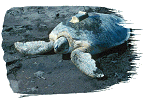Date: January 7, 2002
Contact: Dan Evans
 Miss Junie, an endangered green turtle (Chelonia mydas) being tracked using satellite technology from Tortuguero, Costa Rica, was recently captured and killed by fishermen off the Caribbean coast of Nicaragua.
Miss Junie, an endangered green turtle (Chelonia mydas) being tracked using satellite technology from Tortuguero, Costa Rica, was recently captured and killed by fishermen off the Caribbean coast of Nicaragua.
On September 19, 2000, the Caribbean Conservation Corporation (CCC) attached a satellite transmitter to the shell of the turtle after it had finished nesting on Tortuguero beach (Cyber-Age Turtles to Cruise the Caribbean). The turtle was named Miss Junie in honor of Miss Junie Martínez, one of the most famous residents of Tortuguero village. Once released, the turtle returned to the beach to nest at least twice more in 2000 before swimming north to Nicaragua. Thousands of interested people around the world followed the migration of Miss Junie through CCC’s web site (Miss Junie’s Map) until the signal from the transmitter was lost in August 2001, almost a year after the turtle had left Tortuguero. At that moment “Miss Junie” was 420 km from Tortuguero, close to the Miskito Cays in Nicaragua.
In December 2001, Wildlife Conservation Society biologist Cynthia Lagueux, who works along the Nicaraguan Caribbean coast on turtle protection issues, contacted CCC that she had bought Miss Junie’s satellite transmitter from a local fisherman who had captured and killed a sea turtle off the Nicaraguan coast. Miss Junie was likely sold to a turtle butcher in nearby Puerto Cabezas.
Lagueux had contacted the fisherman after hearding that he had captured a turtle bearing what he described as a “black box.” Realizing the device was actually a transmitter of significant value to turtle research, Lagueux went to see the fisherman to buy the transmitter and return it to its rightful owner. Once she saw it, she realized the device belonged to the CCC. While the transmitter was retrieved intact, the antenna had been severely damaged. The transmitter will be repaired and attached to a new green turtle later this year.
“It is sad that it was Miss Junie. But her capture makes a good point – that sea turtle conservation needs to be an international effort or it won’t work,” said Sebastian Troëng, CCC’s Costa Rican Scientific Director. “Sea turtles don’t recognize borders. Therefore, we are working with representatives to organize international conventions, it’s the only way to protect them.”
The real Miss Junie was sad to hear the news of the green turtle’s death, stating “Here in Tortuguero we protect the turtles and we make a living from the tourists that come here to watch turtle nesting. I hope that some day they can do the same in Nicaragua so they do not have to kill turtles anymore.”
Currently nine countries from the Americas, among them Costa Rica and the U.S., have ratified an international treaty known as the Inter-American Convention for the Protection and Conservation of Sea Turtles. The measure now has enough support to enter into force, and will be subject to a meeting of all supporting countries later this year. Costa Rica is among the countries vying to host the event, in the hopes it will help bolster this country’s image as a trailblazer in wildlife protection.
“There is a problem of jurisdiction and enforcement in Costa Rica and throughout Central America,” said Troëng. “The CCC has been able to work well with the local government authorities in Tortuguero to significantly raise the number of surviving green turtles during nesting season, despite constant threats posed by egg poachers.”
CCC is hopeful that the remaining sea turtles that were released around the same time as Miss Junie are happily swimming home, though the signals have been lost from the transmitters. It is possible the other missing turtles are alive and well, their transmitters are most likely damaged or are out of battery power.
The Sea Turtle Conservancy, formerly known as the Caribbean Conservation Corporation, is a not-for-profit, 501(c)3 organization based in Florida with offices and projects in several other locations. The Sea Turtle Conservancy is the oldest and most accomplished sea turtle organization in the world. Since its founding in 1959, the Sea Turtle Conservancy’s work has greatly improved the survival outlook for several species of sea turtles. The Sea Turtle Conservancy has as its mission the protection of sea turtles and the habitats upon which they depend. To achieve its mission, the Sea Turtle Conservancy uses research, habitat protection, public education, community outreach, networking and advocacy as its basic tools. These tools are applied in both international and domestic programs focusing on geographic areas that are globally important to sea turtle survival. For more information, visit the STC website atwww.conserveturtles.org or call (800) 678-7853.